Teeside University Dissertation: Risk Management in Middle East
VerifiedAdded on 2022/11/28
|55
|16816
|333
Thesis and Dissertation
AI Summary
This dissertation, submitted to Teeside University, investigates risk management strategies for investors in the Middle East. It begins with an introduction outlining the research's background, aims, objectives, and structure. A comprehensive literature review examines the concept of risk management, theoretical and empirical frameworks, and its impact on Middle Eastern investors. The research methodology chapter details the interpretive research philosophy, inductive approach, and secondary data collection methods used. The findings, based on analysis of relevant articles, highlight political and economic risks faced by investors, as well as opportunities for marketing and growth. The dissertation concludes with recommendations for managing risk, emphasizing portfolio diversification and strategic investment decisions. The study aims to provide valuable insights for academics, investors, and practitioners in the field.
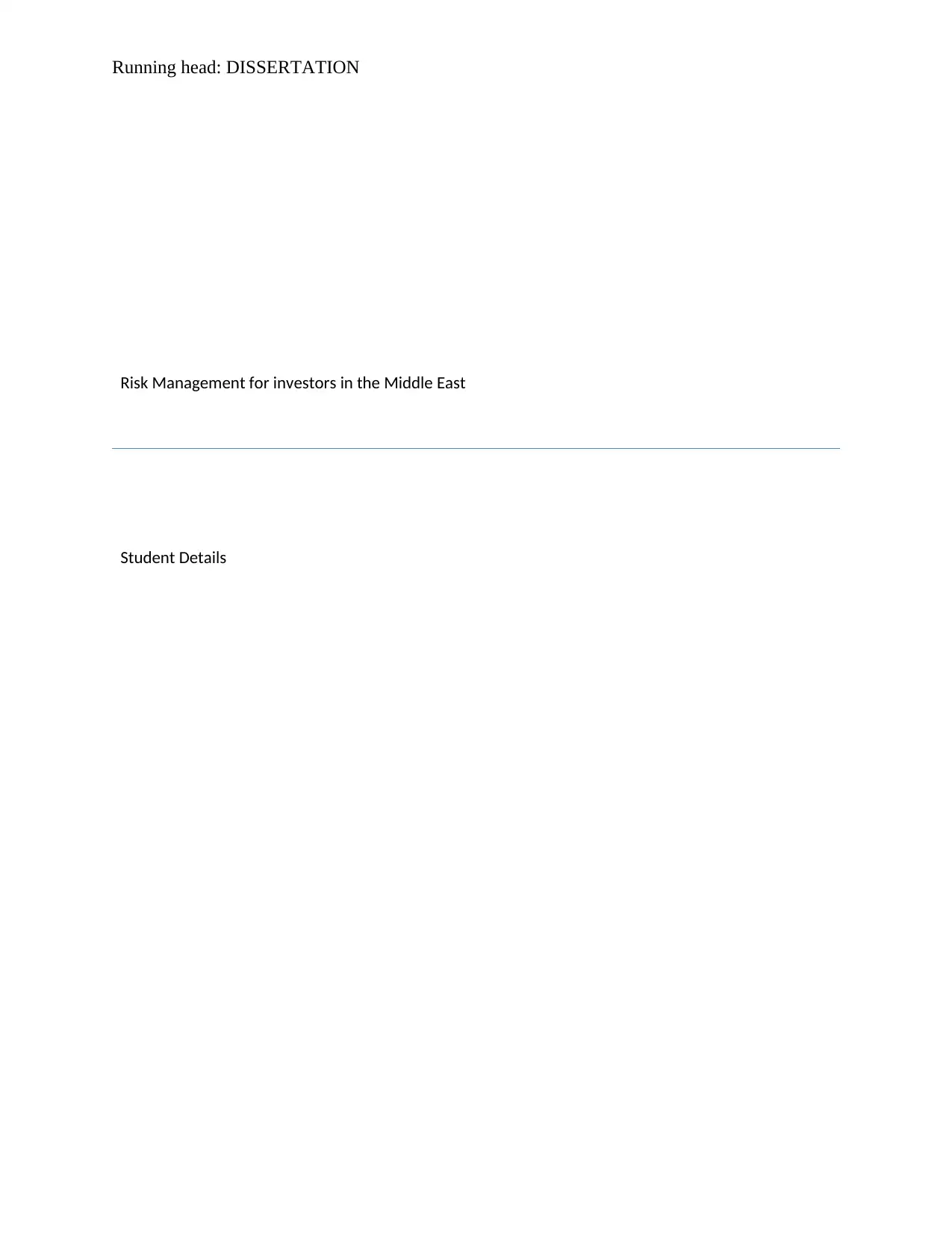
Running head: DISSERTATION
Risk Management for investors in the Middle East
Student Details
Risk Management for investors in the Middle East
Student Details
Paraphrase This Document
Need a fresh take? Get an instant paraphrase of this document with our AI Paraphraser
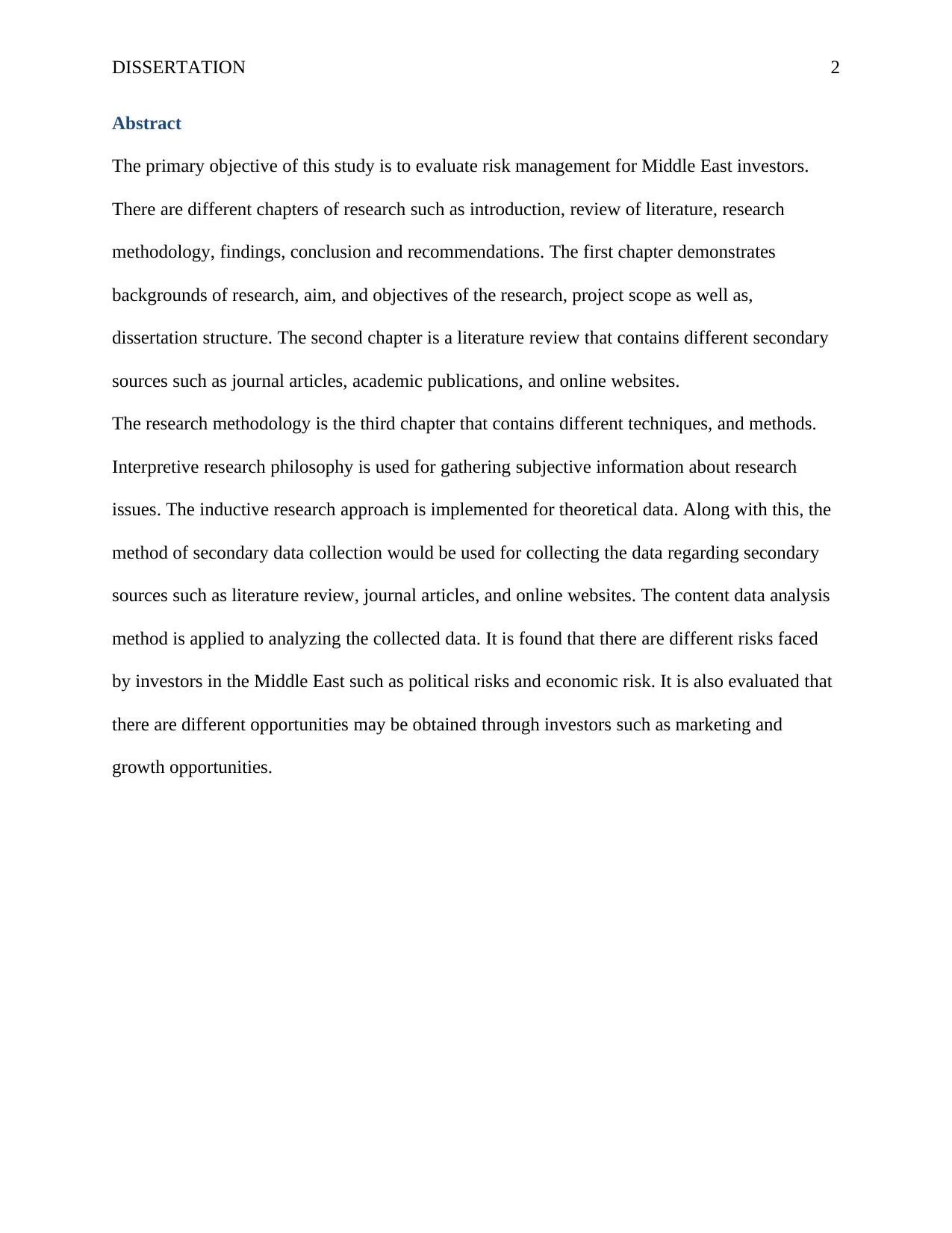
DISSERTATION 2
Abstract
The primary objective of this study is to evaluate risk management for Middle East investors.
There are different chapters of research such as introduction, review of literature, research
methodology, findings, conclusion and recommendations. The first chapter demonstrates
backgrounds of research, aim, and objectives of the research, project scope as well as,
dissertation structure. The second chapter is a literature review that contains different secondary
sources such as journal articles, academic publications, and online websites.
The research methodology is the third chapter that contains different techniques, and methods.
Interpretive research philosophy is used for gathering subjective information about research
issues. The inductive research approach is implemented for theoretical data. Along with this, the
method of secondary data collection would be used for collecting the data regarding secondary
sources such as literature review, journal articles, and online websites. The content data analysis
method is applied to analyzing the collected data. It is found that there are different risks faced
by investors in the Middle East such as political risks and economic risk. It is also evaluated that
there are different opportunities may be obtained through investors such as marketing and
growth opportunities.
Abstract
The primary objective of this study is to evaluate risk management for Middle East investors.
There are different chapters of research such as introduction, review of literature, research
methodology, findings, conclusion and recommendations. The first chapter demonstrates
backgrounds of research, aim, and objectives of the research, project scope as well as,
dissertation structure. The second chapter is a literature review that contains different secondary
sources such as journal articles, academic publications, and online websites.
The research methodology is the third chapter that contains different techniques, and methods.
Interpretive research philosophy is used for gathering subjective information about research
issues. The inductive research approach is implemented for theoretical data. Along with this, the
method of secondary data collection would be used for collecting the data regarding secondary
sources such as literature review, journal articles, and online websites. The content data analysis
method is applied to analyzing the collected data. It is found that there are different risks faced
by investors in the Middle East such as political risks and economic risk. It is also evaluated that
there are different opportunities may be obtained through investors such as marketing and
growth opportunities.
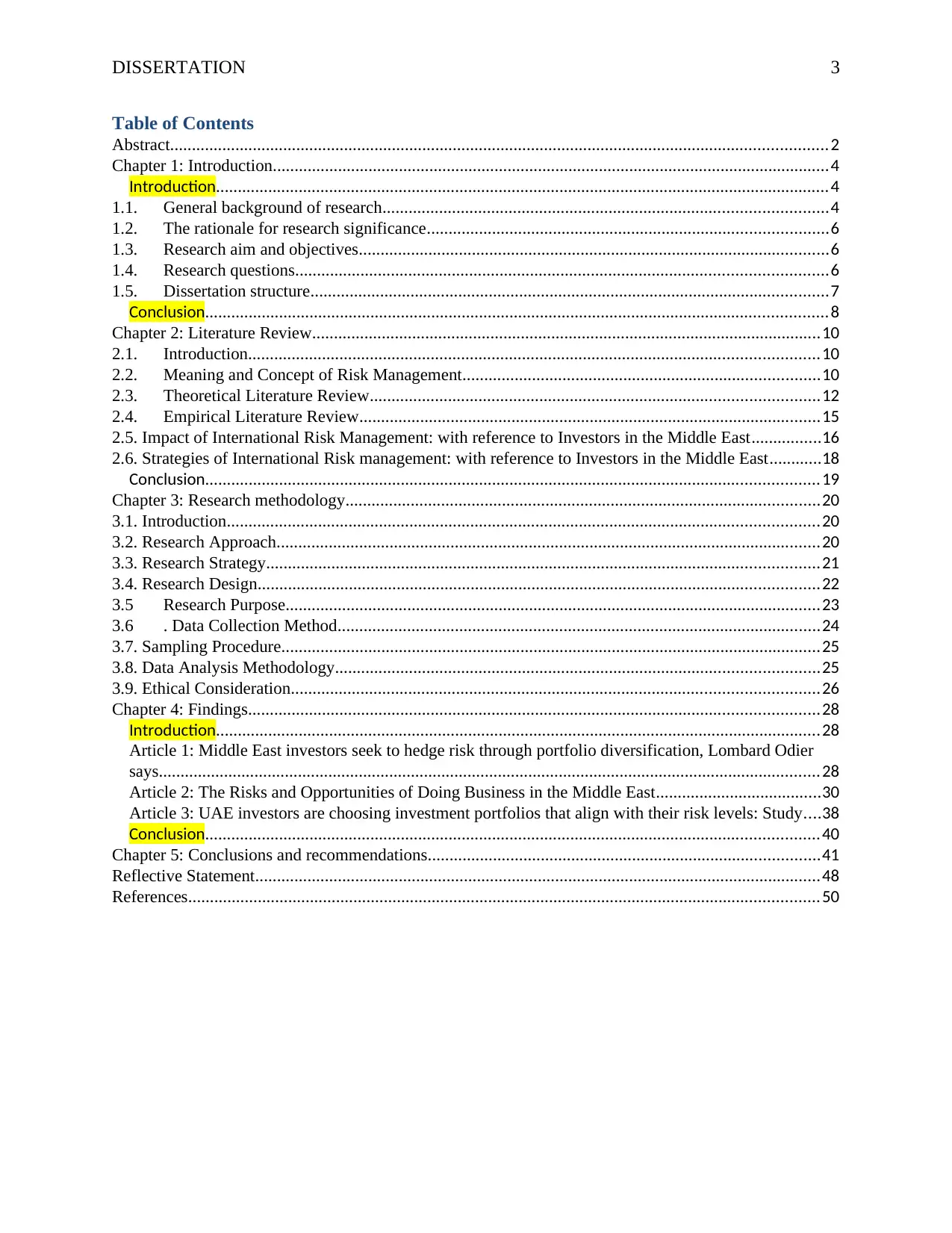
DISSERTATION 3
Table of Contents
Abstract.......................................................................................................................................................2
Chapter 1: Introduction................................................................................................................................4
Introduction.............................................................................................................................................4
1.1. General background of research......................................................................................................4
1.2. The rationale for research significance............................................................................................6
1.3. Research aim and objectives............................................................................................................6
1.4. Research questions..........................................................................................................................6
1.5. Dissertation structure.......................................................................................................................7
Conclusion...............................................................................................................................................8
Chapter 2: Literature Review.....................................................................................................................10
2.1. Introduction...................................................................................................................................10
2.2. Meaning and Concept of Risk Management..................................................................................10
2.3. Theoretical Literature Review.......................................................................................................12
2.4. Empirical Literature Review..........................................................................................................15
2.5. Impact of International Risk Management: with reference to Investors in the Middle East................16
2.6. Strategies of International Risk management: with reference to Investors in the Middle East............18
Conclusion.............................................................................................................................................19
Chapter 3: Research methodology.............................................................................................................20
3.1. Introduction........................................................................................................................................20
3.2. Research Approach.............................................................................................................................20
3.3. Research Strategy...............................................................................................................................21
3.4. Research Design.................................................................................................................................22
3.5 Research Purpose...........................................................................................................................23
3.6 . Data Collection Method...............................................................................................................24
3.7. Sampling Procedure............................................................................................................................25
3.8. Data Analysis Methodology...............................................................................................................25
3.9. Ethical Consideration.........................................................................................................................26
Chapter 4: Findings...................................................................................................................................28
Introduction...........................................................................................................................................28
Article 1: Middle East investors seek to hedge risk through portfolio diversification, Lombard Odier
says........................................................................................................................................................28
Article 2: The Risks and Opportunities of Doing Business in the Middle East......................................30
Article 3: UAE investors are choosing investment portfolios that align with their risk levels: Study....38
Conclusion.............................................................................................................................................40
Chapter 5: Conclusions and recommendations..........................................................................................41
Reflective Statement..................................................................................................................................48
References.................................................................................................................................................50
Table of Contents
Abstract.......................................................................................................................................................2
Chapter 1: Introduction................................................................................................................................4
Introduction.............................................................................................................................................4
1.1. General background of research......................................................................................................4
1.2. The rationale for research significance............................................................................................6
1.3. Research aim and objectives............................................................................................................6
1.4. Research questions..........................................................................................................................6
1.5. Dissertation structure.......................................................................................................................7
Conclusion...............................................................................................................................................8
Chapter 2: Literature Review.....................................................................................................................10
2.1. Introduction...................................................................................................................................10
2.2. Meaning and Concept of Risk Management..................................................................................10
2.3. Theoretical Literature Review.......................................................................................................12
2.4. Empirical Literature Review..........................................................................................................15
2.5. Impact of International Risk Management: with reference to Investors in the Middle East................16
2.6. Strategies of International Risk management: with reference to Investors in the Middle East............18
Conclusion.............................................................................................................................................19
Chapter 3: Research methodology.............................................................................................................20
3.1. Introduction........................................................................................................................................20
3.2. Research Approach.............................................................................................................................20
3.3. Research Strategy...............................................................................................................................21
3.4. Research Design.................................................................................................................................22
3.5 Research Purpose...........................................................................................................................23
3.6 . Data Collection Method...............................................................................................................24
3.7. Sampling Procedure............................................................................................................................25
3.8. Data Analysis Methodology...............................................................................................................25
3.9. Ethical Consideration.........................................................................................................................26
Chapter 4: Findings...................................................................................................................................28
Introduction...........................................................................................................................................28
Article 1: Middle East investors seek to hedge risk through portfolio diversification, Lombard Odier
says........................................................................................................................................................28
Article 2: The Risks and Opportunities of Doing Business in the Middle East......................................30
Article 3: UAE investors are choosing investment portfolios that align with their risk levels: Study....38
Conclusion.............................................................................................................................................40
Chapter 5: Conclusions and recommendations..........................................................................................41
Reflective Statement..................................................................................................................................48
References.................................................................................................................................................50
⊘ This is a preview!⊘
Do you want full access?
Subscribe today to unlock all pages.

Trusted by 1+ million students worldwide
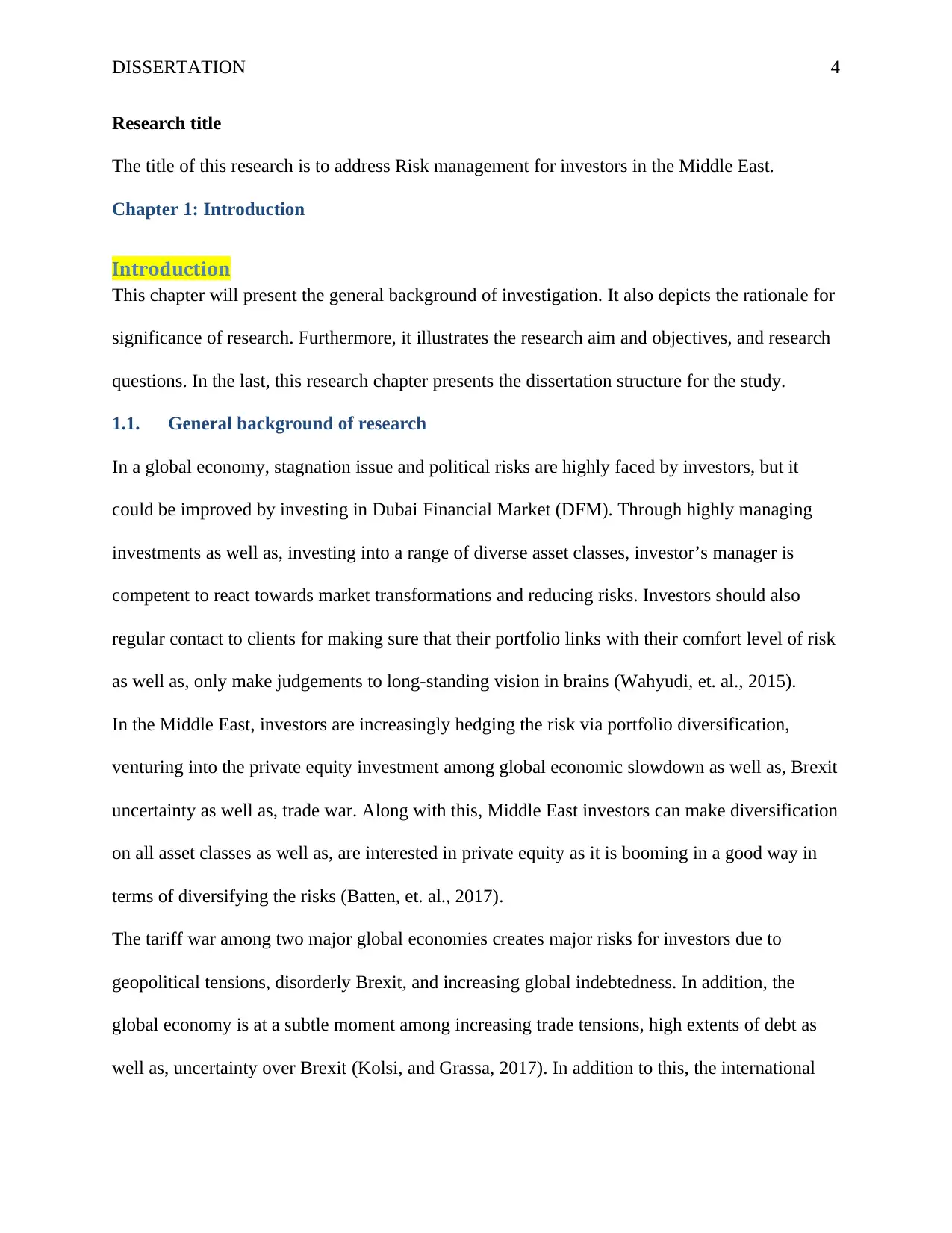
DISSERTATION 4
Research title
The title of this research is to address Risk management for investors in the Middle East.
Chapter 1: Introduction
Introduction
This chapter will present the general background of investigation. It also depicts the rationale for
significance of research. Furthermore, it illustrates the research aim and objectives, and research
questions. In the last, this research chapter presents the dissertation structure for the study.
1.1. General background of research
In a global economy, stagnation issue and political risks are highly faced by investors, but it
could be improved by investing in Dubai Financial Market (DFM). Through highly managing
investments as well as, investing into a range of diverse asset classes, investor’s manager is
competent to react towards market transformations and reducing risks. Investors should also
regular contact to clients for making sure that their portfolio links with their comfort level of risk
as well as, only make judgements to long-standing vision in brains (Wahyudi, et. al., 2015).
In the Middle East, investors are increasingly hedging the risk via portfolio diversification,
venturing into the private equity investment among global economic slowdown as well as, Brexit
uncertainty as well as, trade war. Along with this, Middle East investors can make diversification
on all asset classes as well as, are interested in private equity as it is booming in a good way in
terms of diversifying the risks (Batten, et. al., 2017).
The tariff war among two major global economies creates major risks for investors due to
geopolitical tensions, disorderly Brexit, and increasing global indebtedness. In addition, the
global economy is at a subtle moment among increasing trade tensions, high extents of debt as
well as, uncertainty over Brexit (Kolsi, and Grassa, 2017). In addition to this, the international
Research title
The title of this research is to address Risk management for investors in the Middle East.
Chapter 1: Introduction
Introduction
This chapter will present the general background of investigation. It also depicts the rationale for
significance of research. Furthermore, it illustrates the research aim and objectives, and research
questions. In the last, this research chapter presents the dissertation structure for the study.
1.1. General background of research
In a global economy, stagnation issue and political risks are highly faced by investors, but it
could be improved by investing in Dubai Financial Market (DFM). Through highly managing
investments as well as, investing into a range of diverse asset classes, investor’s manager is
competent to react towards market transformations and reducing risks. Investors should also
regular contact to clients for making sure that their portfolio links with their comfort level of risk
as well as, only make judgements to long-standing vision in brains (Wahyudi, et. al., 2015).
In the Middle East, investors are increasingly hedging the risk via portfolio diversification,
venturing into the private equity investment among global economic slowdown as well as, Brexit
uncertainty as well as, trade war. Along with this, Middle East investors can make diversification
on all asset classes as well as, are interested in private equity as it is booming in a good way in
terms of diversifying the risks (Batten, et. al., 2017).
The tariff war among two major global economies creates major risks for investors due to
geopolitical tensions, disorderly Brexit, and increasing global indebtedness. In addition, the
global economy is at a subtle moment among increasing trade tensions, high extents of debt as
well as, uncertainty over Brexit (Kolsi, and Grassa, 2017). In addition to this, the international
Paraphrase This Document
Need a fresh take? Get an instant paraphrase of this document with our AI Paraphraser
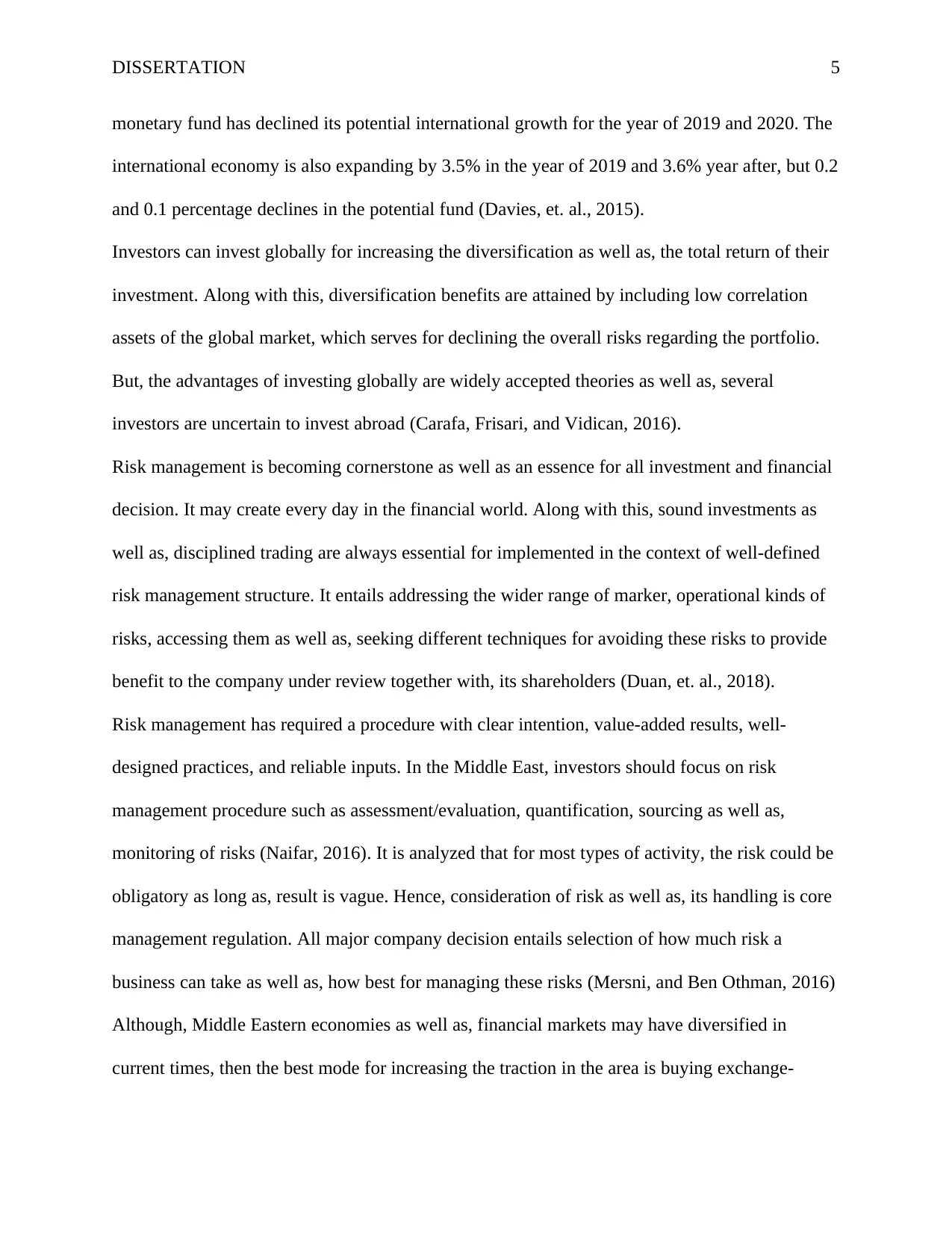
DISSERTATION 5
monetary fund has declined its potential international growth for the year of 2019 and 2020. The
international economy is also expanding by 3.5% in the year of 2019 and 3.6% year after, but 0.2
and 0.1 percentage declines in the potential fund (Davies, et. al., 2015).
Investors can invest globally for increasing the diversification as well as, the total return of their
investment. Along with this, diversification benefits are attained by including low correlation
assets of the global market, which serves for declining the overall risks regarding the portfolio.
But, the advantages of investing globally are widely accepted theories as well as, several
investors are uncertain to invest abroad (Carafa, Frisari, and Vidican, 2016).
Risk management is becoming cornerstone as well as an essence for all investment and financial
decision. It may create every day in the financial world. Along with this, sound investments as
well as, disciplined trading are always essential for implemented in the context of well-defined
risk management structure. It entails addressing the wider range of marker, operational kinds of
risks, accessing them as well as, seeking different techniques for avoiding these risks to provide
benefit to the company under review together with, its shareholders (Duan, et. al., 2018).
Risk management has required a procedure with clear intention, value-added results, well-
designed practices, and reliable inputs. In the Middle East, investors should focus on risk
management procedure such as assessment/evaluation, quantification, sourcing as well as,
monitoring of risks (Naifar, 2016). It is analyzed that for most types of activity, the risk could be
obligatory as long as, result is vague. Hence, consideration of risk as well as, its handling is core
management regulation. All major company decision entails selection of how much risk a
business can take as well as, how best for managing these risks (Mersni, and Ben Othman, 2016)
Although, Middle Eastern economies as well as, financial markets may have diversified in
current times, then the best mode for increasing the traction in the area is buying exchange-
monetary fund has declined its potential international growth for the year of 2019 and 2020. The
international economy is also expanding by 3.5% in the year of 2019 and 3.6% year after, but 0.2
and 0.1 percentage declines in the potential fund (Davies, et. al., 2015).
Investors can invest globally for increasing the diversification as well as, the total return of their
investment. Along with this, diversification benefits are attained by including low correlation
assets of the global market, which serves for declining the overall risks regarding the portfolio.
But, the advantages of investing globally are widely accepted theories as well as, several
investors are uncertain to invest abroad (Carafa, Frisari, and Vidican, 2016).
Risk management is becoming cornerstone as well as an essence for all investment and financial
decision. It may create every day in the financial world. Along with this, sound investments as
well as, disciplined trading are always essential for implemented in the context of well-defined
risk management structure. It entails addressing the wider range of marker, operational kinds of
risks, accessing them as well as, seeking different techniques for avoiding these risks to provide
benefit to the company under review together with, its shareholders (Duan, et. al., 2018).
Risk management has required a procedure with clear intention, value-added results, well-
designed practices, and reliable inputs. In the Middle East, investors should focus on risk
management procedure such as assessment/evaluation, quantification, sourcing as well as,
monitoring of risks (Naifar, 2016). It is analyzed that for most types of activity, the risk could be
obligatory as long as, result is vague. Hence, consideration of risk as well as, its handling is core
management regulation. All major company decision entails selection of how much risk a
business can take as well as, how best for managing these risks (Mersni, and Ben Othman, 2016)
Although, Middle Eastern economies as well as, financial markets may have diversified in
current times, then the best mode for increasing the traction in the area is buying exchange-
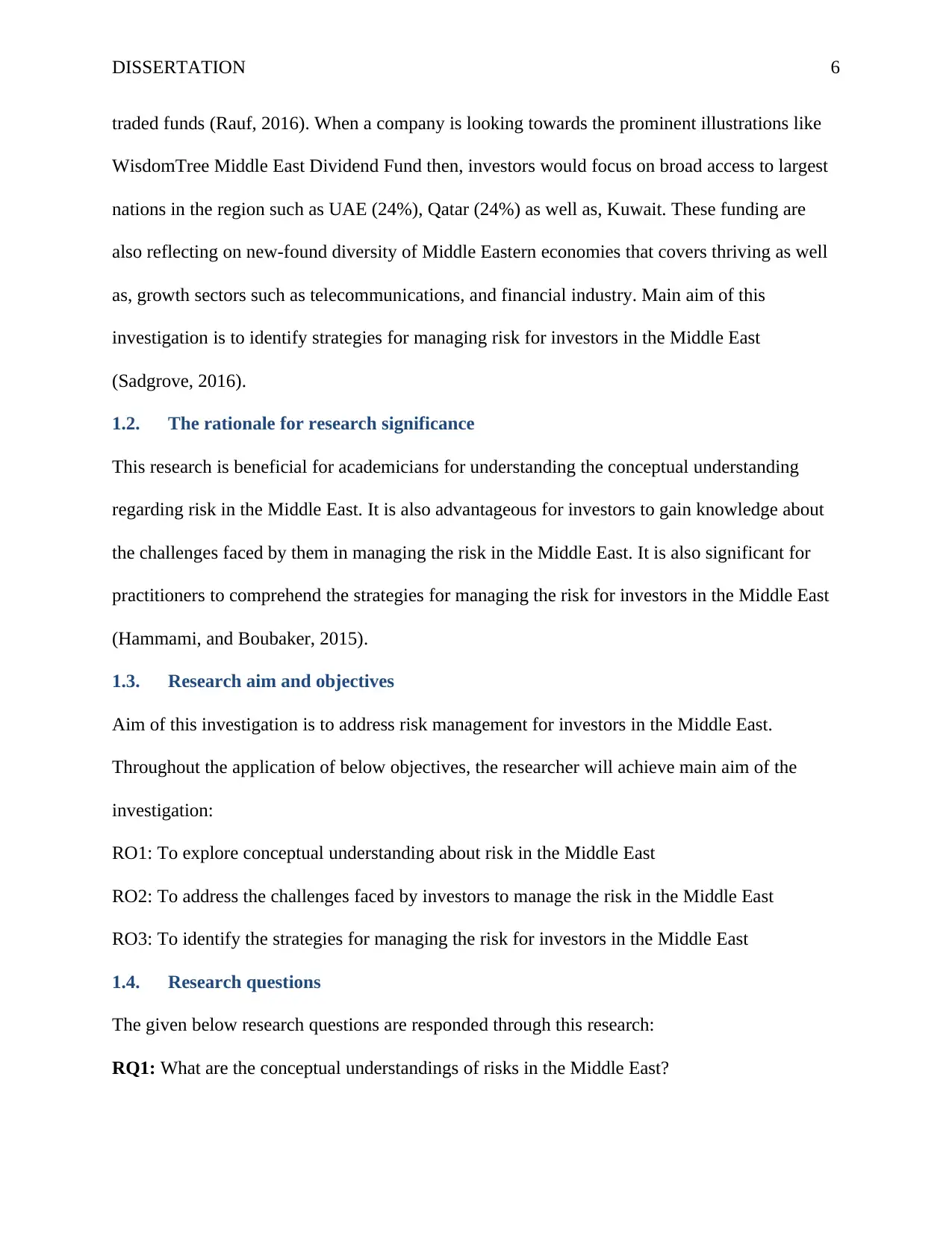
DISSERTATION 6
traded funds (Rauf, 2016). When a company is looking towards the prominent illustrations like
WisdomTree Middle East Dividend Fund then, investors would focus on broad access to largest
nations in the region such as UAE (24%), Qatar (24%) as well as, Kuwait. These funding are
also reflecting on new-found diversity of Middle Eastern economies that covers thriving as well
as, growth sectors such as telecommunications, and financial industry. Main aim of this
investigation is to identify strategies for managing risk for investors in the Middle East
(Sadgrove, 2016).
1.2. The rationale for research significance
This research is beneficial for academicians for understanding the conceptual understanding
regarding risk in the Middle East. It is also advantageous for investors to gain knowledge about
the challenges faced by them in managing the risk in the Middle East. It is also significant for
practitioners to comprehend the strategies for managing the risk for investors in the Middle East
(Hammami, and Boubaker, 2015).
1.3. Research aim and objectives
Aim of this investigation is to address risk management for investors in the Middle East.
Throughout the application of below objectives, the researcher will achieve main aim of the
investigation:
RO1: To explore conceptual understanding about risk in the Middle East
RO2: To address the challenges faced by investors to manage the risk in the Middle East
RO3: To identify the strategies for managing the risk for investors in the Middle East
1.4. Research questions
The given below research questions are responded through this research:
RQ1: What are the conceptual understandings of risks in the Middle East?
traded funds (Rauf, 2016). When a company is looking towards the prominent illustrations like
WisdomTree Middle East Dividend Fund then, investors would focus on broad access to largest
nations in the region such as UAE (24%), Qatar (24%) as well as, Kuwait. These funding are
also reflecting on new-found diversity of Middle Eastern economies that covers thriving as well
as, growth sectors such as telecommunications, and financial industry. Main aim of this
investigation is to identify strategies for managing risk for investors in the Middle East
(Sadgrove, 2016).
1.2. The rationale for research significance
This research is beneficial for academicians for understanding the conceptual understanding
regarding risk in the Middle East. It is also advantageous for investors to gain knowledge about
the challenges faced by them in managing the risk in the Middle East. It is also significant for
practitioners to comprehend the strategies for managing the risk for investors in the Middle East
(Hammami, and Boubaker, 2015).
1.3. Research aim and objectives
Aim of this investigation is to address risk management for investors in the Middle East.
Throughout the application of below objectives, the researcher will achieve main aim of the
investigation:
RO1: To explore conceptual understanding about risk in the Middle East
RO2: To address the challenges faced by investors to manage the risk in the Middle East
RO3: To identify the strategies for managing the risk for investors in the Middle East
1.4. Research questions
The given below research questions are responded through this research:
RQ1: What are the conceptual understandings of risks in the Middle East?
⊘ This is a preview!⊘
Do you want full access?
Subscribe today to unlock all pages.

Trusted by 1+ million students worldwide
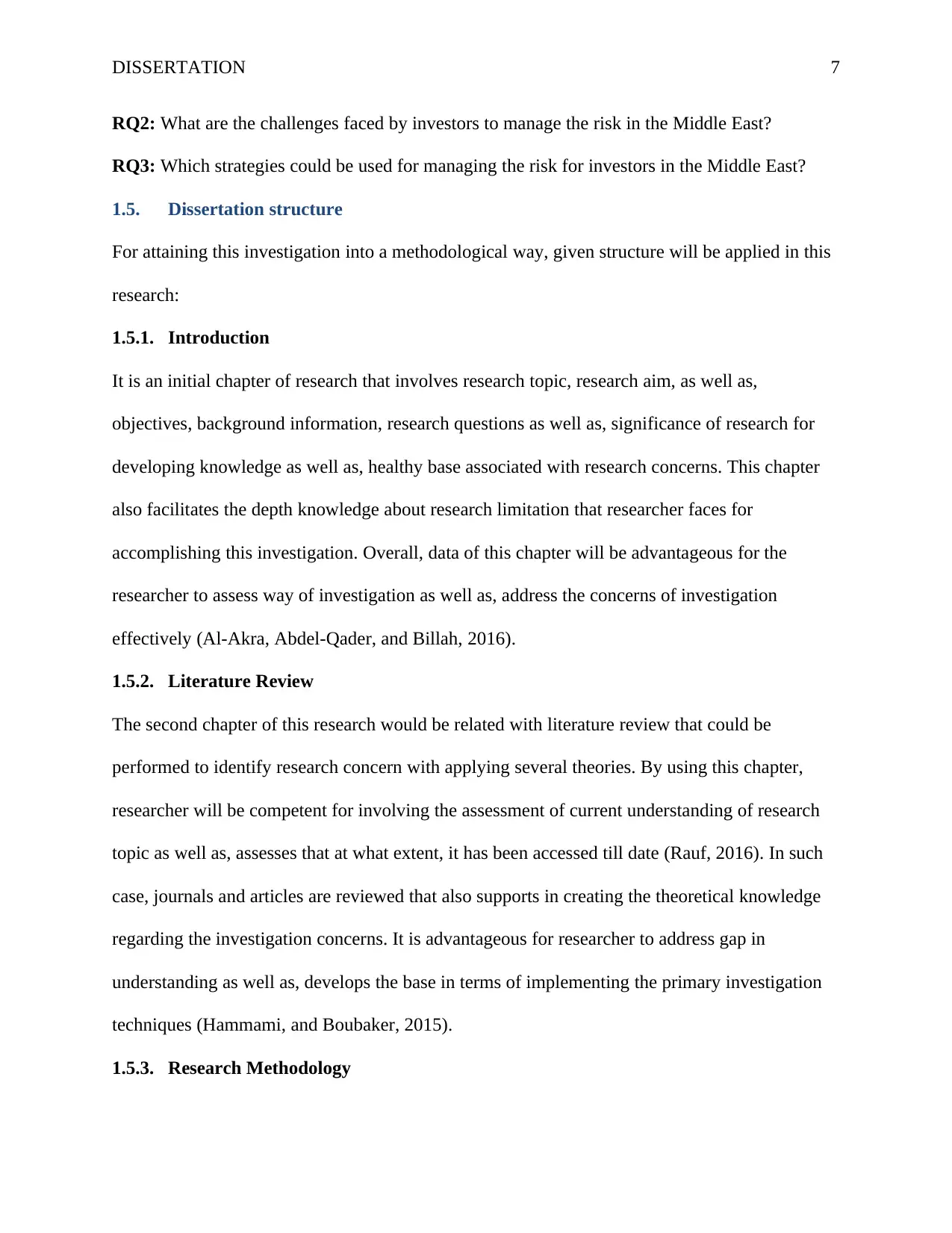
DISSERTATION 7
RQ2: What are the challenges faced by investors to manage the risk in the Middle East?
RQ3: Which strategies could be used for managing the risk for investors in the Middle East?
1.5. Dissertation structure
For attaining this investigation into a methodological way, given structure will be applied in this
research:
1.5.1. Introduction
It is an initial chapter of research that involves research topic, research aim, as well as,
objectives, background information, research questions as well as, significance of research for
developing knowledge as well as, healthy base associated with research concerns. This chapter
also facilitates the depth knowledge about research limitation that researcher faces for
accomplishing this investigation. Overall, data of this chapter will be advantageous for the
researcher to assess way of investigation as well as, address the concerns of investigation
effectively (Al-Akra, Abdel-Qader, and Billah, 2016).
1.5.2. Literature Review
The second chapter of this research would be related with literature review that could be
performed to identify research concern with applying several theories. By using this chapter,
researcher will be competent for involving the assessment of current understanding of research
topic as well as, assesses that at what extent, it has been accessed till date (Rauf, 2016). In such
case, journals and articles are reviewed that also supports in creating the theoretical knowledge
regarding the investigation concerns. It is advantageous for researcher to address gap in
understanding as well as, develops the base in terms of implementing the primary investigation
techniques (Hammami, and Boubaker, 2015).
1.5.3. Research Methodology
RQ2: What are the challenges faced by investors to manage the risk in the Middle East?
RQ3: Which strategies could be used for managing the risk for investors in the Middle East?
1.5. Dissertation structure
For attaining this investigation into a methodological way, given structure will be applied in this
research:
1.5.1. Introduction
It is an initial chapter of research that involves research topic, research aim, as well as,
objectives, background information, research questions as well as, significance of research for
developing knowledge as well as, healthy base associated with research concerns. This chapter
also facilitates the depth knowledge about research limitation that researcher faces for
accomplishing this investigation. Overall, data of this chapter will be advantageous for the
researcher to assess way of investigation as well as, address the concerns of investigation
effectively (Al-Akra, Abdel-Qader, and Billah, 2016).
1.5.2. Literature Review
The second chapter of this research would be related with literature review that could be
performed to identify research concern with applying several theories. By using this chapter,
researcher will be competent for involving the assessment of current understanding of research
topic as well as, assesses that at what extent, it has been accessed till date (Rauf, 2016). In such
case, journals and articles are reviewed that also supports in creating the theoretical knowledge
regarding the investigation concerns. It is advantageous for researcher to address gap in
understanding as well as, develops the base in terms of implementing the primary investigation
techniques (Hammami, and Boubaker, 2015).
1.5.3. Research Methodology
Paraphrase This Document
Need a fresh take? Get an instant paraphrase of this document with our AI Paraphraser
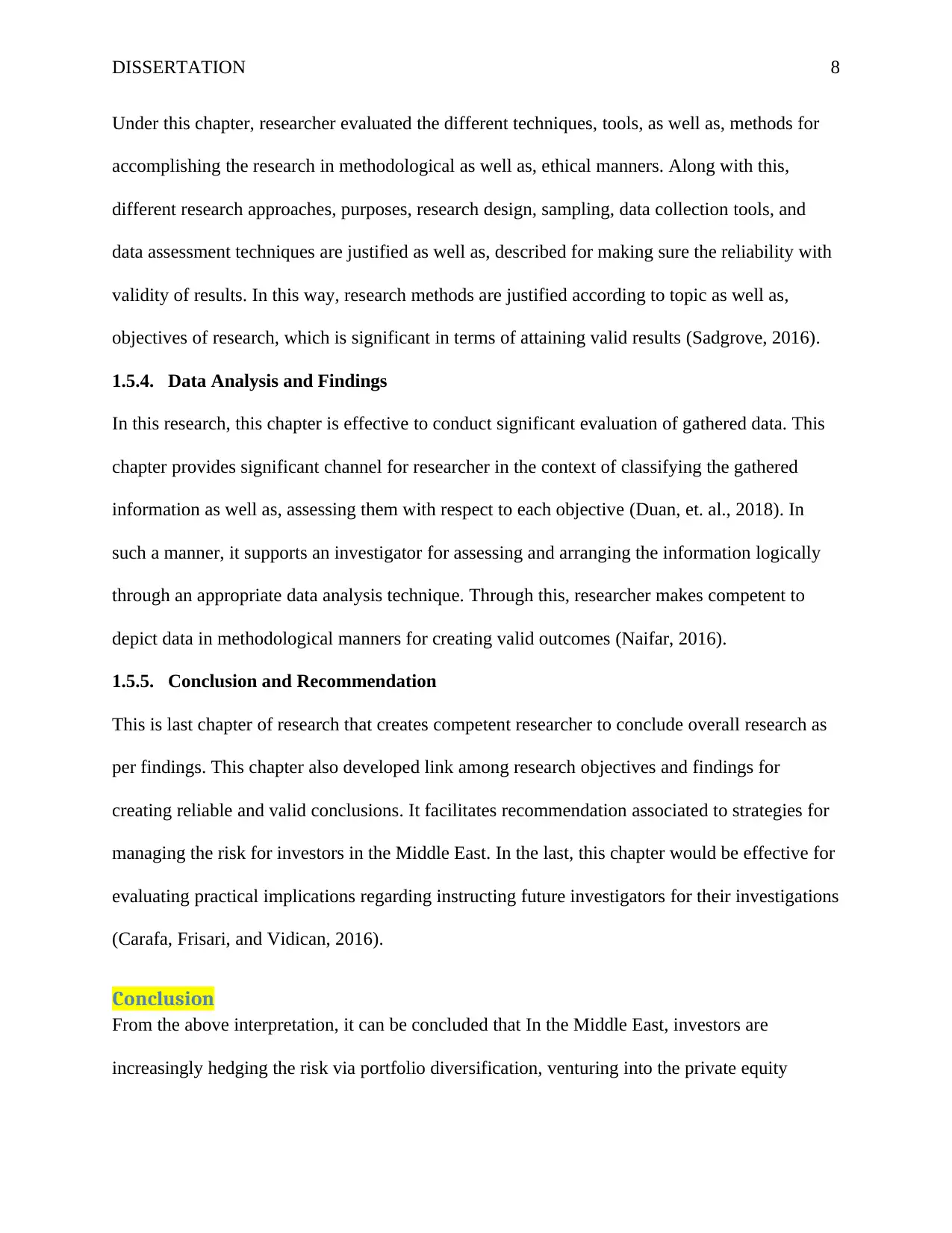
DISSERTATION 8
Under this chapter, researcher evaluated the different techniques, tools, as well as, methods for
accomplishing the research in methodological as well as, ethical manners. Along with this,
different research approaches, purposes, research design, sampling, data collection tools, and
data assessment techniques are justified as well as, described for making sure the reliability with
validity of results. In this way, research methods are justified according to topic as well as,
objectives of research, which is significant in terms of attaining valid results (Sadgrove, 2016).
1.5.4. Data Analysis and Findings
In this research, this chapter is effective to conduct significant evaluation of gathered data. This
chapter provides significant channel for researcher in the context of classifying the gathered
information as well as, assessing them with respect to each objective (Duan, et. al., 2018). In
such a manner, it supports an investigator for assessing and arranging the information logically
through an appropriate data analysis technique. Through this, researcher makes competent to
depict data in methodological manners for creating valid outcomes (Naifar, 2016).
1.5.5. Conclusion and Recommendation
This is last chapter of research that creates competent researcher to conclude overall research as
per findings. This chapter also developed link among research objectives and findings for
creating reliable and valid conclusions. It facilitates recommendation associated to strategies for
managing the risk for investors in the Middle East. In the last, this chapter would be effective for
evaluating practical implications regarding instructing future investigators for their investigations
(Carafa, Frisari, and Vidican, 2016).
Conclusion
From the above interpretation, it can be concluded that In the Middle East, investors are
increasingly hedging the risk via portfolio diversification, venturing into the private equity
Under this chapter, researcher evaluated the different techniques, tools, as well as, methods for
accomplishing the research in methodological as well as, ethical manners. Along with this,
different research approaches, purposes, research design, sampling, data collection tools, and
data assessment techniques are justified as well as, described for making sure the reliability with
validity of results. In this way, research methods are justified according to topic as well as,
objectives of research, which is significant in terms of attaining valid results (Sadgrove, 2016).
1.5.4. Data Analysis and Findings
In this research, this chapter is effective to conduct significant evaluation of gathered data. This
chapter provides significant channel for researcher in the context of classifying the gathered
information as well as, assessing them with respect to each objective (Duan, et. al., 2018). In
such a manner, it supports an investigator for assessing and arranging the information logically
through an appropriate data analysis technique. Through this, researcher makes competent to
depict data in methodological manners for creating valid outcomes (Naifar, 2016).
1.5.5. Conclusion and Recommendation
This is last chapter of research that creates competent researcher to conclude overall research as
per findings. This chapter also developed link among research objectives and findings for
creating reliable and valid conclusions. It facilitates recommendation associated to strategies for
managing the risk for investors in the Middle East. In the last, this chapter would be effective for
evaluating practical implications regarding instructing future investigators for their investigations
(Carafa, Frisari, and Vidican, 2016).
Conclusion
From the above interpretation, it can be concluded that In the Middle East, investors are
increasingly hedging the risk via portfolio diversification, venturing into the private equity
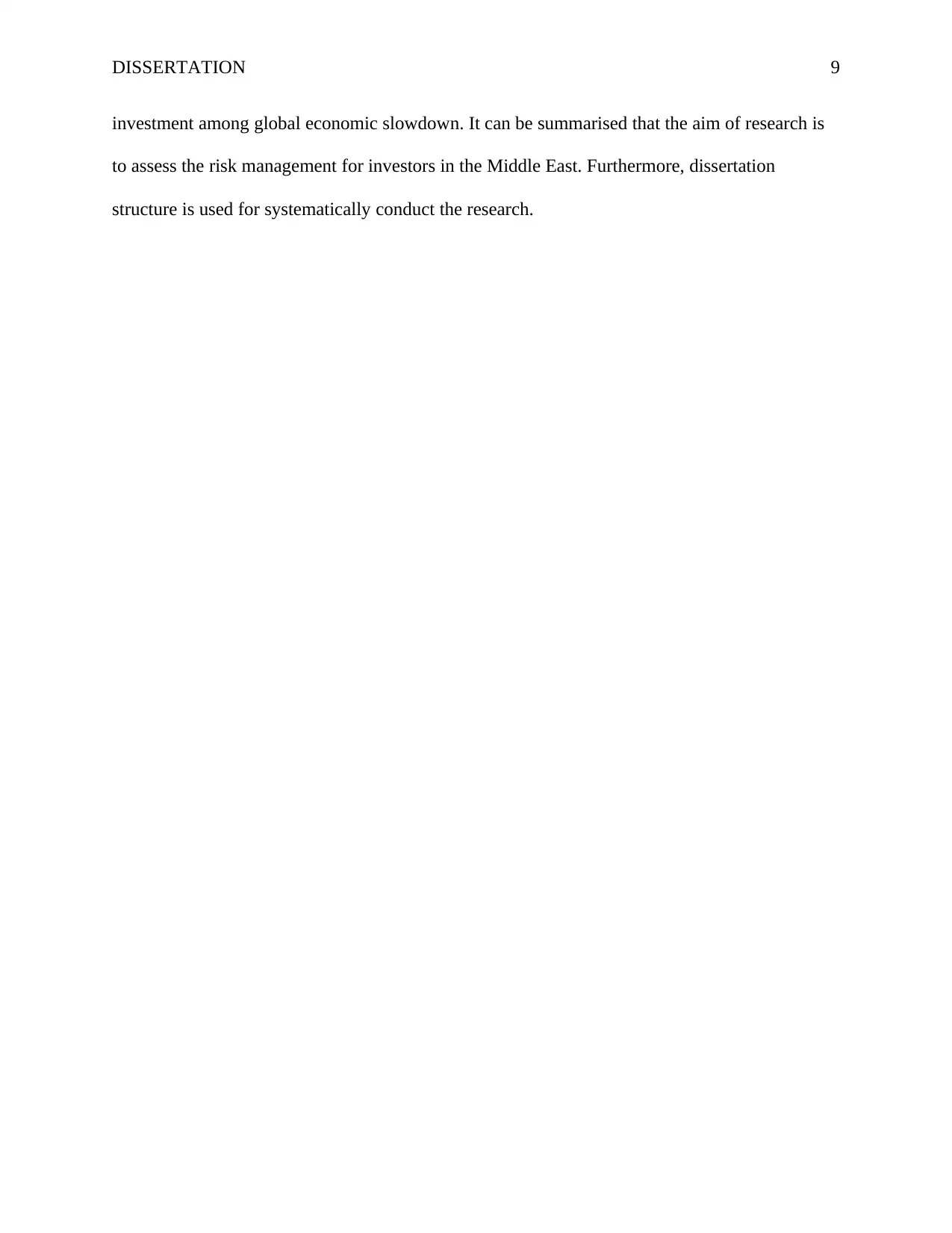
DISSERTATION 9
investment among global economic slowdown. It can be summarised that the aim of research is
to assess the risk management for investors in the Middle East. Furthermore, dissertation
structure is used for systematically conduct the research.
investment among global economic slowdown. It can be summarised that the aim of research is
to assess the risk management for investors in the Middle East. Furthermore, dissertation
structure is used for systematically conduct the research.
⊘ This is a preview!⊘
Do you want full access?
Subscribe today to unlock all pages.

Trusted by 1+ million students worldwide
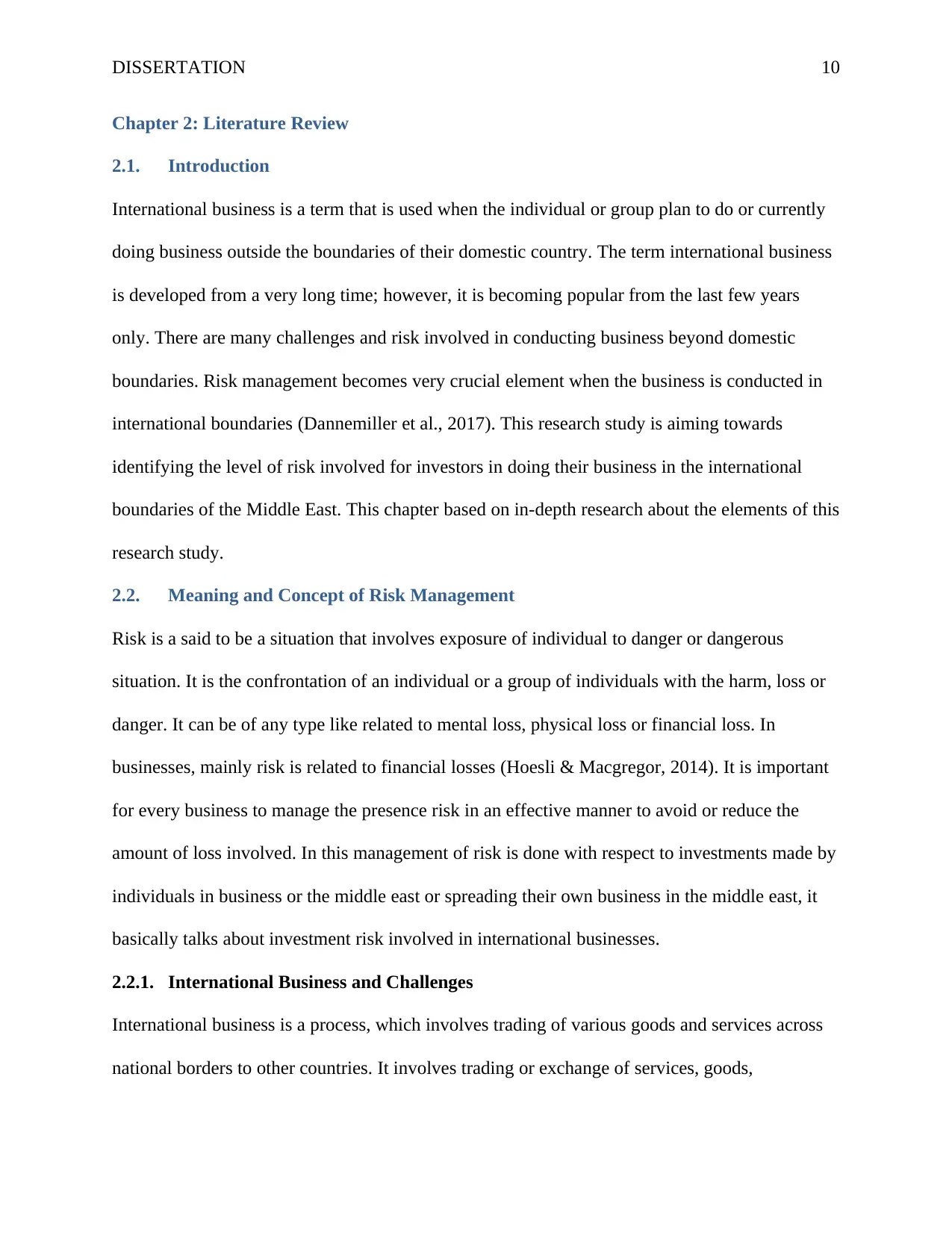
DISSERTATION 10
Chapter 2: Literature Review
2.1. Introduction
International business is a term that is used when the individual or group plan to do or currently
doing business outside the boundaries of their domestic country. The term international business
is developed from a very long time; however, it is becoming popular from the last few years
only. There are many challenges and risk involved in conducting business beyond domestic
boundaries. Risk management becomes very crucial element when the business is conducted in
international boundaries (Dannemiller et al., 2017). This research study is aiming towards
identifying the level of risk involved for investors in doing their business in the international
boundaries of the Middle East. This chapter based on in-depth research about the elements of this
research study.
2.2. Meaning and Concept of Risk Management
Risk is a said to be a situation that involves exposure of individual to danger or dangerous
situation. It is the confrontation of an individual or a group of individuals with the harm, loss or
danger. It can be of any type like related to mental loss, physical loss or financial loss. In
businesses, mainly risk is related to financial losses (Hoesli & Macgregor, 2014). It is important
for every business to manage the presence risk in an effective manner to avoid or reduce the
amount of loss involved. In this management of risk is done with respect to investments made by
individuals in business or the middle east or spreading their own business in the middle east, it
basically talks about investment risk involved in international businesses.
2.2.1. International Business and Challenges
International business is a process, which involves trading of various goods and services across
national borders to other countries. It involves trading or exchange of services, goods,
Chapter 2: Literature Review
2.1. Introduction
International business is a term that is used when the individual or group plan to do or currently
doing business outside the boundaries of their domestic country. The term international business
is developed from a very long time; however, it is becoming popular from the last few years
only. There are many challenges and risk involved in conducting business beyond domestic
boundaries. Risk management becomes very crucial element when the business is conducted in
international boundaries (Dannemiller et al., 2017). This research study is aiming towards
identifying the level of risk involved for investors in doing their business in the international
boundaries of the Middle East. This chapter based on in-depth research about the elements of this
research study.
2.2. Meaning and Concept of Risk Management
Risk is a said to be a situation that involves exposure of individual to danger or dangerous
situation. It is the confrontation of an individual or a group of individuals with the harm, loss or
danger. It can be of any type like related to mental loss, physical loss or financial loss. In
businesses, mainly risk is related to financial losses (Hoesli & Macgregor, 2014). It is important
for every business to manage the presence risk in an effective manner to avoid or reduce the
amount of loss involved. In this management of risk is done with respect to investments made by
individuals in business or the middle east or spreading their own business in the middle east, it
basically talks about investment risk involved in international businesses.
2.2.1. International Business and Challenges
International business is a process, which involves trading of various goods and services across
national borders to other countries. It involves trading or exchange of services, goods,
Paraphrase This Document
Need a fresh take? Get an instant paraphrase of this document with our AI Paraphraser
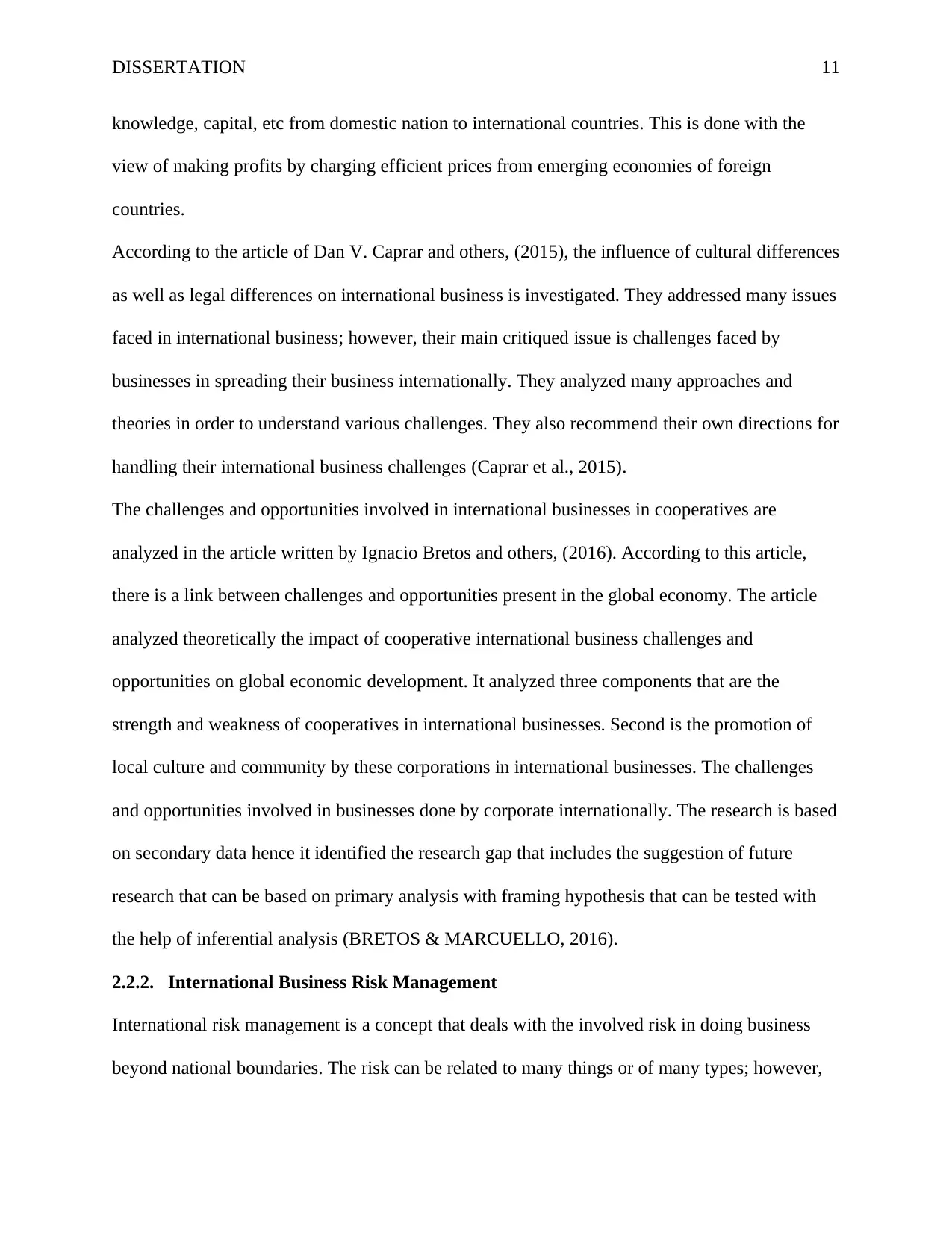
DISSERTATION 11
knowledge, capital, etc from domestic nation to international countries. This is done with the
view of making profits by charging efficient prices from emerging economies of foreign
countries.
According to the article of Dan V. Caprar and others, (2015), the influence of cultural differences
as well as legal differences on international business is investigated. They addressed many issues
faced in international business; however, their main critiqued issue is challenges faced by
businesses in spreading their business internationally. They analyzed many approaches and
theories in order to understand various challenges. They also recommend their own directions for
handling their international business challenges (Caprar et al., 2015).
The challenges and opportunities involved in international businesses in cooperatives are
analyzed in the article written by Ignacio Bretos and others, (2016). According to this article,
there is a link between challenges and opportunities present in the global economy. The article
analyzed theoretically the impact of cooperative international business challenges and
opportunities on global economic development. It analyzed three components that are the
strength and weakness of cooperatives in international businesses. Second is the promotion of
local culture and community by these corporations in international businesses. The challenges
and opportunities involved in businesses done by corporate internationally. The research is based
on secondary data hence it identified the research gap that includes the suggestion of future
research that can be based on primary analysis with framing hypothesis that can be tested with
the help of inferential analysis (BRETOS & MARCUELLO, 2016).
2.2.2. International Business Risk Management
International risk management is a concept that deals with the involved risk in doing business
beyond national boundaries. The risk can be related to many things or of many types; however,
knowledge, capital, etc from domestic nation to international countries. This is done with the
view of making profits by charging efficient prices from emerging economies of foreign
countries.
According to the article of Dan V. Caprar and others, (2015), the influence of cultural differences
as well as legal differences on international business is investigated. They addressed many issues
faced in international business; however, their main critiqued issue is challenges faced by
businesses in spreading their business internationally. They analyzed many approaches and
theories in order to understand various challenges. They also recommend their own directions for
handling their international business challenges (Caprar et al., 2015).
The challenges and opportunities involved in international businesses in cooperatives are
analyzed in the article written by Ignacio Bretos and others, (2016). According to this article,
there is a link between challenges and opportunities present in the global economy. The article
analyzed theoretically the impact of cooperative international business challenges and
opportunities on global economic development. It analyzed three components that are the
strength and weakness of cooperatives in international businesses. Second is the promotion of
local culture and community by these corporations in international businesses. The challenges
and opportunities involved in businesses done by corporate internationally. The research is based
on secondary data hence it identified the research gap that includes the suggestion of future
research that can be based on primary analysis with framing hypothesis that can be tested with
the help of inferential analysis (BRETOS & MARCUELLO, 2016).
2.2.2. International Business Risk Management
International risk management is a concept that deals with the involved risk in doing business
beyond national boundaries. The risk can be related to many things or of many types; however,
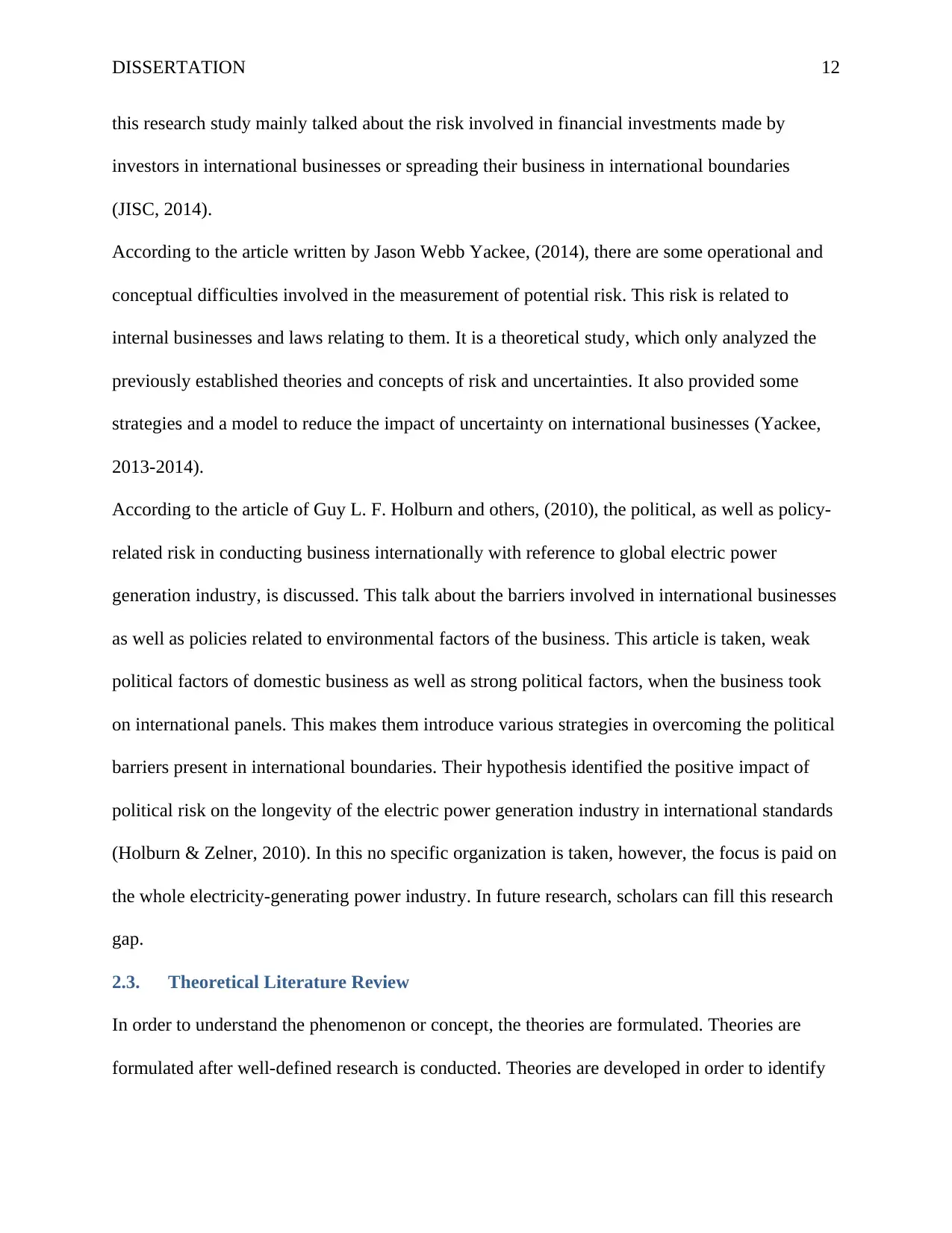
DISSERTATION 12
this research study mainly talked about the risk involved in financial investments made by
investors in international businesses or spreading their business in international boundaries
(JISC, 2014).
According to the article written by Jason Webb Yackee, (2014), there are some operational and
conceptual difficulties involved in the measurement of potential risk. This risk is related to
internal businesses and laws relating to them. It is a theoretical study, which only analyzed the
previously established theories and concepts of risk and uncertainties. It also provided some
strategies and a model to reduce the impact of uncertainty on international businesses (Yackee,
2013-2014).
According to the article of Guy L. F. Holburn and others, (2010), the political, as well as policy-
related risk in conducting business internationally with reference to global electric power
generation industry, is discussed. This talk about the barriers involved in international businesses
as well as policies related to environmental factors of the business. This article is taken, weak
political factors of domestic business as well as strong political factors, when the business took
on international panels. This makes them introduce various strategies in overcoming the political
barriers present in international boundaries. Their hypothesis identified the positive impact of
political risk on the longevity of the electric power generation industry in international standards
(Holburn & Zelner, 2010). In this no specific organization is taken, however, the focus is paid on
the whole electricity-generating power industry. In future research, scholars can fill this research
gap.
2.3. Theoretical Literature Review
In order to understand the phenomenon or concept, the theories are formulated. Theories are
formulated after well-defined research is conducted. Theories are developed in order to identify
this research study mainly talked about the risk involved in financial investments made by
investors in international businesses or spreading their business in international boundaries
(JISC, 2014).
According to the article written by Jason Webb Yackee, (2014), there are some operational and
conceptual difficulties involved in the measurement of potential risk. This risk is related to
internal businesses and laws relating to them. It is a theoretical study, which only analyzed the
previously established theories and concepts of risk and uncertainties. It also provided some
strategies and a model to reduce the impact of uncertainty on international businesses (Yackee,
2013-2014).
According to the article of Guy L. F. Holburn and others, (2010), the political, as well as policy-
related risk in conducting business internationally with reference to global electric power
generation industry, is discussed. This talk about the barriers involved in international businesses
as well as policies related to environmental factors of the business. This article is taken, weak
political factors of domestic business as well as strong political factors, when the business took
on international panels. This makes them introduce various strategies in overcoming the political
barriers present in international boundaries. Their hypothesis identified the positive impact of
political risk on the longevity of the electric power generation industry in international standards
(Holburn & Zelner, 2010). In this no specific organization is taken, however, the focus is paid on
the whole electricity-generating power industry. In future research, scholars can fill this research
gap.
2.3. Theoretical Literature Review
In order to understand the phenomenon or concept, the theories are formulated. Theories are
formulated after well-defined research is conducted. Theories are developed in order to identify
⊘ This is a preview!⊘
Do you want full access?
Subscribe today to unlock all pages.

Trusted by 1+ million students worldwide
1 out of 55
Related Documents
Your All-in-One AI-Powered Toolkit for Academic Success.
+13062052269
info@desklib.com
Available 24*7 on WhatsApp / Email
![[object Object]](/_next/static/media/star-bottom.7253800d.svg)
Unlock your academic potential
Copyright © 2020–2025 A2Z Services. All Rights Reserved. Developed and managed by ZUCOL.





